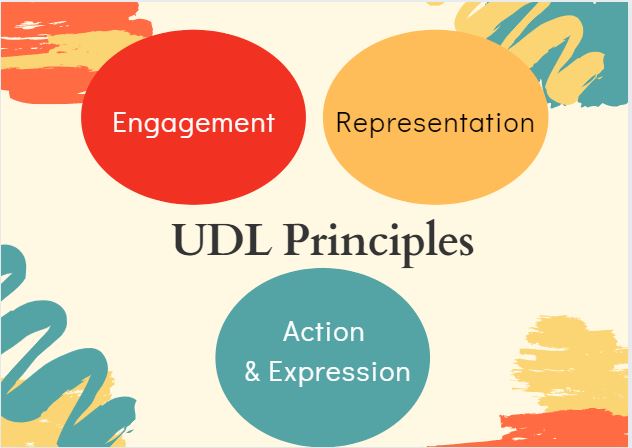Based on my existing experience as a college instructor and academic coordinator I have witnessed that the way people learn is unique to each other. UDL framework aims to maximize learning and eliminating the barrier for the trainees.
The selected video explained what the Universal Design for Learning is and how it can transform the learning experience for the diverse learners.
The curriculum should be designed that can be used and understood by each learner despite of their learning needs, background, and interests. The question arises here how educators can make a curriculum that suits all diverse learners?
The answer is to design a flexible curriculum. Here is the need for practical implementation by planning a curriculum that is flexible according to all kinds of trainees.
UDL framework can be implemented by covering 3 aspects:
- The teacher must think what is the class objective and goal for the students to achieve?
- What can be the barrier that might conflict for the group of diverse learners?
- How to eliminate the barriers by the implementation of the UDL principles?

Let’s talk about each UDL principle individually:
- Representation: Use of multimedia to present lesson content using a graphic, animation, and break down the difficult vocabulary for further explanation. That will help students to be an agent of their learning.
- Action: Providing students various opportunities to demonstrate what they have learned. For instance, individual feedback, peer assessment, and group work based on their needs and proficiency.
- Engagement: The lesson should support and boost students’ engagement. Involve trainees and give them the freedom to design their learning method. It is ok to make mistakes they will be learning from experience. The main idea is that they will achieve the goal while getting engaged throughout the learning process using their interests.
References:
AHEAD. (2017, November 02). What is Universal Design for Learning (UDL)? [Video]. YouTube. https://www.youtube.com/watch?v=AGQ_7K35ysA
Allison Posey. Universal Design for Learning (UDL): A teacher’s guide Retrieved from https://www.understood.org/articles/en/understanding-universal-design-for-learning#

2021-09-19 at 10:59 pm
Thank you for your post, Anum!
I really liked that you incorporated different forms of multimedia into your post (picture, video, and info poster).
I totally agree with you that every learner is unique, so we have to provide a diverse and flexible curriculum to meet everyone’s needs. In your experience as a college instructor and academic coordinator, how well do you think the current state of education incorporates the UDL principles?
2021-09-24 at 11:30 pm
Hi Tyanna,
Thank you for your comments and question!
To answer your query, I would like to say that it depends on the individual instructor that how UDL principle is incorporated with the recent education.
For instance, in Information Technology class the instructor can demonstrate practically how to assemble a computer afterward show a video representing different ways of assembling. It can be further supported as scenario-based projects, individual tasks, and group work assignments. Hence, by implementing multiple strategies to present content, use a variety of materials, providing cognitive support, and using a variety of learning styles with flexible opportunities, UDL principle can be effectively executed in recent education.
Thanks,
Anum
2021-09-20 at 2:27 am
Hey
Thanks for sharing your blog on our communicating site, made this so much easier to comment on. I really like all the media you used for this blog post, and hearing it from an instructor side. I can tell you put in a lot of work for this post and the research done. I also agree with the UDL Principles and the steps represented.
2021-09-24 at 11:31 pm
Hi Saelex,
Thanks for taking the time to read my blog and I appreciate all the positive feedback.
Thanks,
Anum
2021-09-20 at 4:30 pm
Hey Anum,
Great post! Definitely looks like you’ve put a lot of work into it. I liked your incorporation of multimedia, I will definitely be doing the same in the future. I agree with the points you’ve raised in this post regarding individuals having unique learning styles. I was wondering what your thoughts are on the current teaching methods at UVic based on your experience?
2021-09-24 at 11:33 pm
Hi Musab,
Thank you for your comments and to tell me how much you liked my blog.
Well, my experience with the current teaching methods at Uvic is outstanding. Our instructors used a variety of teaching methods to support diverse learners for example I witness the student-centered / constructivist approach, inquiry-based learning, and project-based learning during my classes.
Thanks,
Anum
2021-09-21 at 10:10 am
Hi Anum,
Very good read, the pictures communicated the visual aspects of your story. It’s good to see someone who had experience with the learning theories.
2021-09-24 at 11:35 pm
Hi Asaprookie,
Thank you for reading my blog and share your positive thought.
Thank,
Anum
2021-09-22 at 6:45 pm
Hi Anum! Thank you for your great post!
I love your choice of video and your post engages the readers to take a step further into thinking about how we can use UDL in our future lesson planning.
I personally still feel like I sometimes feel a bit unsure (usually feels like there might be an even better way) when it comes to assessment. I thought about it after learning about this week’s topic, and came to the point where the important thing is to focus on the process. I am curious to hear what your thoughts are on effective assessment strategies within UDL framework!
Hope to hear back your thoughts! 🙂
2021-09-24 at 11:39 pm
Hi Japaneseteacher,
Thank you for your comments and question!
I appreciate all the positive feedback that you have provided for my blog.
To answer your query, I would like to say that it is crucial to design and implement an effective assessment strategy based on the learner’s style and requirements. One assessment type cannot fit all the learners’ needs.
Therefore, an instructor needs to identify the strength, weaknesses of the learner, recognize the need and styles of the individual trainee by tracking the progress and collecting feedback for the current teaching methods.
Based on these outcomes instructors can use quizzes, tests, state-administered standardized tests, and essays. In some cases, self-evaluation is proven as an efficient approach where trainees assess their performance, as well as peer-evaluation, is another productive method that allows the student to evaluate the performance of each other thus get an opportunity to learn from each other experiences.
Thanks,
Anum
2021-09-29 at 9:59 am
Hi Anum,
Thank you for your response!
I see, thank you for sharing the steps and detailed ideas on how to create an effective assessment plan. I love how you mentioned not everyone fits in a single assessment type, and looking back at my own experience as a student, I cannot agree more.
I really like the self and peer assessment strategies for they tackle students strength from multiple angles – not just focusing on what you are good at, but an individual can also learn a lot by looking into and analyzing other people’s strength.
Thank you for sharing your insights Anum! I look forward to reading more of your blog posts and building/bouncing ideas with you!
Anna
2021-10-18 at 4:16 pm
Hi Anna,
Yes, same here looking forward to exchanging ideas. It is great to get connected with someone with sharing same interests.
Thanks,
Anum
2021-12-01 at 10:15 pm
Hi Anum,
I really enjoy reading your blog! I like the way you explain the benefits of using UDL principles in teaching, the pictures you choose matched the content perfectly, and the video explains the principle well. nice work!
Jun yang